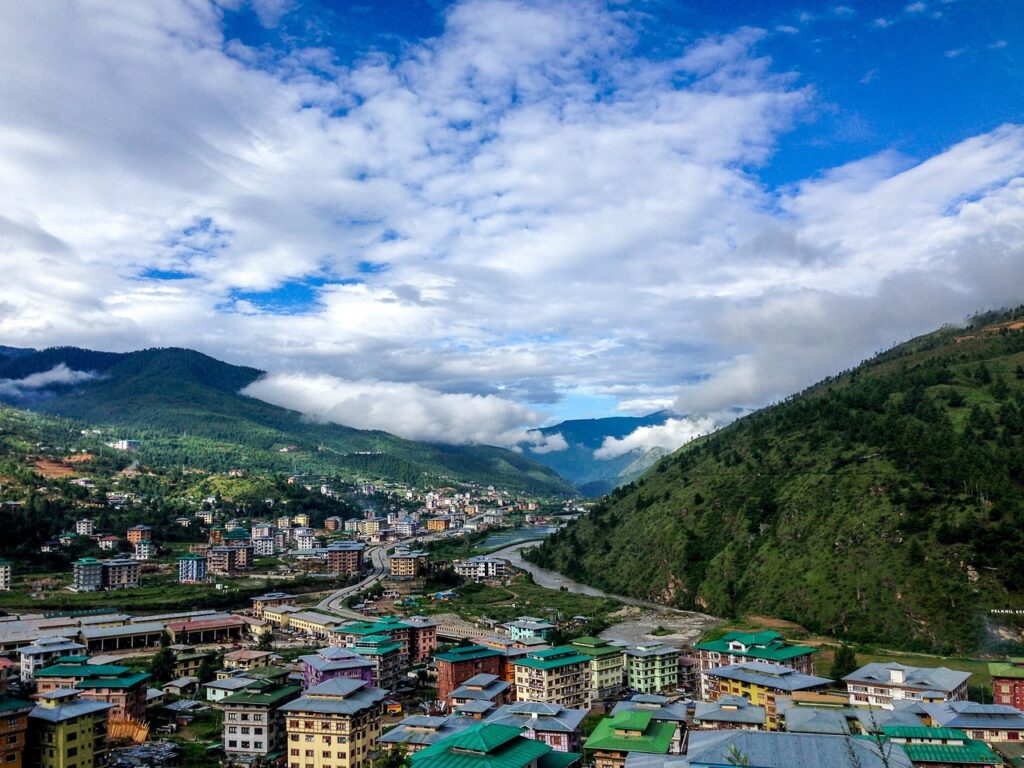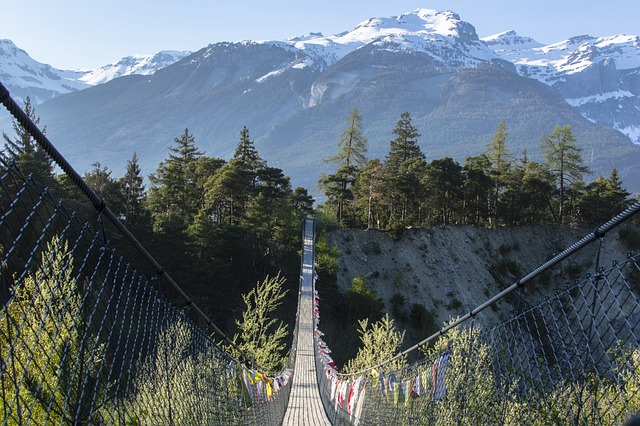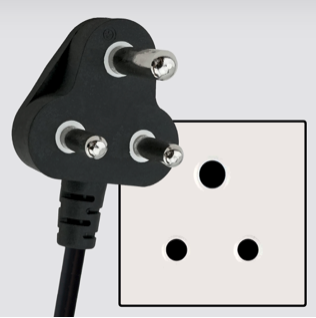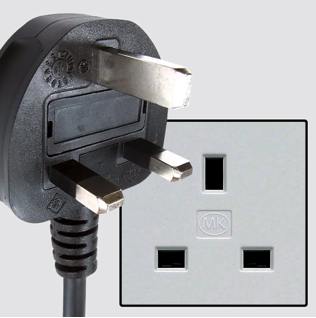Bhutan / འབྲུག་རྒྱལ་ཁབ – Let’s explore here
What’s it like in Bhutan?
Bhutan is a stunningly beautiful, mountainous, landlocked country in south Asia. Located in the Himalayas, between India and Tibet Autonomus region in China, it has a very long and rich history. The steep mountains of the north give way to lower forested mountains in the centre before becoming plains at the border with India. The highest point is Gangkhar Puensum, in the north of Bhutan, at 24,839 ft (7,571 m) above sea level. The peak is the highest unclimbed mountain in the world (2024).
It’s about the size of Switzerland, and has a population of around ¾ million people, about one in six of whom live in the capital, Thimphu.


A bit about the history of Bhutan
Early History and Kingdom Formation
The history of Bhutan dates back to the 8th century when the region was introduced to Buddhism, which would later become a defining element of its culture and identity. The country was initially divided into small, warring kingdoms and territories. By the 17th century, a unifying force emerged under the leadership of Shabdrung Ngawang Namgyal, a lama who unified Bhutan through military conquest and religious influence. He established the Drukpa Kagyu school of Tibetan Buddhism as the state religion, and his legacy led to the creation of Bhutan as a unified kingdom.
The Age of Isolation
For much of its history, Bhutan remained isolated from the outside world, maintaining a policy of self reliance and limiting foreign influence. This isolation was driven in part by the country’s rugged geography and a strong sense of national identity. Bhutan was able to preserve its culture and religious practices while avoiding the political instability that affected other parts of the region, such as British India.
Relations with British India
In the 19th century, Bhutan began to interact more with British India, primarily due to the British Empire’s growing interest in securing the region. After a brief conflict in 1864-1865, Bhutan signed the Treaty of Sinchula, ceding some of its territory to the British in exchange for a subsidy and recognition of its sovereignty. Though Bhutan remained independent, the British had a strong influence over its foreign affairs, and the country maintained a protectorate relationship with British until India gained independence.
The Establishment of the Modern State
Bhutan’s modern political structure began to take shape in the early 20th century. In 1907, Ugyen Wangchuck was crowned the first King of Bhutan, marking the establishment of the Wangchuck dynasty, which continues to rule the country today. The Wangchucks strengthened Bhutan’s independence and internal governance, while maintaining good relations with British India, and later, with independent India after 1947.
Post-Independence and Modernisation
After India’s independence in 1947, Bhutan’s relationship with India became crucial for its security and economic development. Bhutan signed a treaty with India in 1949, which allowed India to influence Bhutan’s foreign policy while guaranteeing Bhutan’s sovereignty. In the latter half of the 20th century, Bhutan began to modernise its economy and infrastructure, although it remained committed to preserving its unique culture and traditions.
Democracy and Political Reforms
In 2008, Bhutan transitioned from an absolute monarchy to a constitutional monarchy, marking a significant shift in its political system. The Fourth King, Jigme Singye Wangchuck, initiated democratic reforms, culminating in the introduction of a new constitution and the first multi-party elections. The king voluntarily abdicated the throne in favour of his son, Jigme Khesar Namgyel Wangchuck, who became the fifth king of Bhutan.
Economic Growth and Environmental Stewardship
Bhutan has made strides in economic development, primarily through agriculture, hydropower and tourism. The country is also known for its unique approach to measuring progress, with the concept of Gross National Happiness being used as a gauge for development, focusing on well-being rather than traditional economic indicators like GDP. Bhutan has also become known for its environmental policies, such as its commitment to remain carbon-neutral and preserve its forests, which cover over 70% of the country’s land area.
Contemporary Bhutan
Today, Bhutan is a small but peaceful country known for its rich cultural heritage and natural beauty. While it continues to face challenges like poverty and a need for economic diversification, it remains committed to preserving its culture, environment and unique political system. Bhutan maintains a close relationship with India, but it also seeks to engage with the international community, balancing modernisation with the preservation of its traditions.

Bhutan road trip
Bhutan imposes a daily sustainable development fee of US$100 a day on all nationals except Indians, Maldivians, and Bangladeshis.
We haven’t finished our planning for our road trip through Bhutan yet. When we do though, we’ll post it here, and in the blog.
Hopefully our journey will improve our knowledge of this intriguing and beautiful country, and enable us to meet some interesting people. We’ll be updating this page at that time – don’t forget to check back 🙂
Map of Bhutan

What’s it like to drive in Bhutan?
They drive on the left hand side of the road in Bhutan. In the main, roads are very poor, with many being unsurfaced dirt tracks. Driving standards are also poor.
Do you require an international driving permit in Bhutan?
We’ve created a dedicated page to driving abroad, which answers this question, and more, which you might find helpful.
Can you use your UK driving license when driving through Bhutan?
We’ve created a dedicated page to driving abroad, which answers this question, and more, which you might find helpful.
Do I need a carnet de passages to drive in Bhutan?
We’ve created a dedicated page to driving abroad, which answers this question, and more, which you might find helpful.
What currency do they use in Bhutan?
In Bhutan they use the ngultrum, although Indian rupees can also be used. Cash is widely used. The use of credit / debit cards is not widely accepted. Travellers cheques are not readily accepted. There are many ATMs in major cities and tourist areas only.
You should make yourself aware of the amount that your bank charges you for using credit and debit cards abroad. Often credit cards are cheaper for purchasing items directly, and for withdrawing cash from ATMs.
What language do they speak in Bhutan?
They speak many different languages in Bhutan, although the official language is Dzongkha. However only about a quarter of the people speak Dzongkha. Other widely spoken languages include Nepali and Tshangla. English is spoken in some tourist areas.
What time zone is Bhutan in?
Remember, when you’re planning your next trip to take a look at what time zone it’s in.
Do I need a visa to visit Bhutan?
We’ve created a dedicated, more comprehensive page on visas, which you should find helpful. Check it out!
Is wild camping legal in Bhutan?
No, wild camping is illegal in Bhutan.
What plug / socket type do they use in Bhutan?
In Bhutan they use plug / socket types D, F and G.



Health issues in Bhutan
Is it safe to drink water in Bhutan?
No, it is not safe to drink tap water in Bhutan. Bottled water is readily available throughout the country.
What vaccinations are required for Bhutan?
This NHS website is kept up to date with all relevant information on vaccinations in Bhutan.
Phones in Bhutan
What is the country calling code for Bhutan?
The country calling code for Bhutan is +975
What are the emergency phone numbers in Bhutan?
- The emergency number for police in Bhutan is: 113
- In Bhutan, the emergency number for ambulance is: 112
- The emergency number for fire in Bhutan is: 110
If you’ve got some useful info that you’d like to share, let us know!
And don’t forget to check out all the other pictures!
